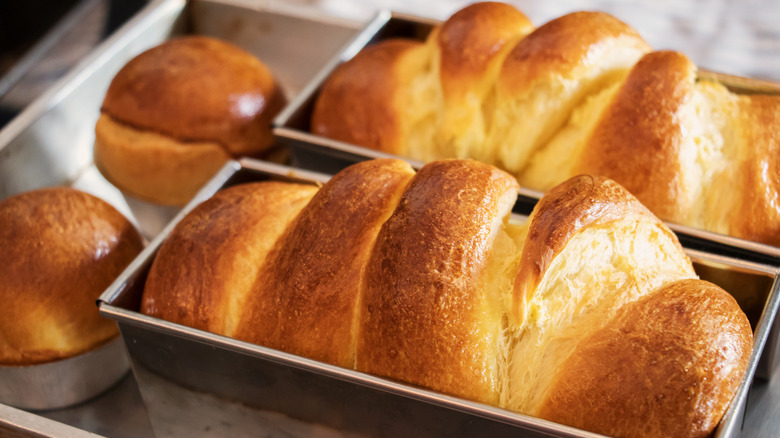Ina Garten's Go-To Source For Good Brioche Bread
We may receive a commission on purchases made from links.
Delicious, buttery brioche bread is so soft and rich that it walks the line between bread and pastry. It's what the French call viennoiserie — yeasted baked goods that are flaky due to their quick rise, and a touch decadent thanks to their high-fat content, usually in the form of lots of butter — like croissants. Enjoyed in sweet applications as well as savory, it is as at home in French toast and bread pudding as when it's used as hot dog or hamburger buns.
Not one to shy away from picking favorites, the revered Barefoot Contessa, author and chef Ina Garten, calls out her brioche preference in her book, "Cook Like A Pro," where she notes specifically that she uses the small loaves available from Eli Zabar's on Manhattan's Upper East Side. It's not the first time she's mentioned sourcing ingredients from her longtime friend and mentor's market, delicatessen, or bakery. In fact, for her perfected version of a peanut butter and jelly sandwich, she insists on using a French jam made exclusively for Eli Zaber by Les Confitures de la Création, which would be fantastic on toasted brioche too. If the Contessa has taught us one thing, it's that, quite often, store-bought is fine.
The difference between brioche and challah
Ina Garten uses brioche and challah bread interchangeably. In "Barefoot Contessa Parties!" — the cookbook's instructions for her challah French toast note that it can be made with brioche. Challah is a ceremonial Jewish bread eaten on Shabbat and other holidays – although not at Passover when observant Jews abstain from eating leavened foods. It's so tasty, however, that even outside of the Jewish community, many enjoy the beautifully braided loaves regularly. The two types of eggy bread are similar, but there's one important difference between challah and brioche — butter.
Challah is made without dairy so that it remains parve, a neutral food that those who follow the laws of kosher can consume with either meat or dairy. Brioche, on the other hand, relies on butter for its light and crumbly texture and full-bodied flavor, along with milk. For its fat, challah dough is instead enriched with oil.
For those who do not keep kosher, challah can be made with butter for a richer flavor, and that's exactly how Eli Zabar makes his. As he explained to Insider, it's made with "lots of butter, and lots of butter, and lots of butter ... and farm fresh eggs. It's almost like a cake but not as sweet." In Zabar's bakery, challah bread is considered to be a brioche and is sold in one-and-a-half pound loaves. He also offers dairy-free kosher loaves by the pair, prepared in a separate certified kitchen, sans butter.
Let them eat brioche
Eli Zabar's makes traditional brioche varieties as well as seasonal specialties, and the market's online store offers shipping. Wonderfully soft brioche hamburger rolls are sold by the half-dozen, and the shop suggests trying them stuffed with crab cakes or fried eggs. Zabar's brioche hotdog buns double as sausage and lobster rolls. They come pull-apart style in six-packs, ready for parties and barbecues. The holidays have inspired Easter bunny-shaped brioche, and Christmas time brings a 12" braided brioche wreath complete with a red bow. Display it, devour it, or send it as a delightful, edible gift.
Ina Garten features brioche throughout her recipes — there's even one for making it in her cookbook "Barefoot in Paris," where she uses a store-bought variety to make her brioche croutons. She specifies brioche for her grilled burger sliders, and buns for her cheddar and chutney on brioche come from Eli's oven where the bread is baked twice daily for fresh day and night delivery.
While the saying, "Let them eat cake," is often falsely attributed to Marie-Antoinette, that isn't how the quote actually translates. The actual words (as written by Rousseau) were, "Qu'ils mangent de la brioche" — rather than referring to cake, the aristocrat's remark was instead referencing the equally luxurious bread — an insensitive comment considering the many people starving in poverty at the time. Today, while still a luxury, brioche is no longer just the bread of rich royalty and can be affordably purchased or made from scratch.



